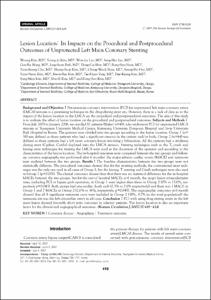KUMEL Repository
1. Journal Papers (연구논문)
1. School of Medicine (의과대학)
Dept. of Internal Medicine (내과학)
Lesion Location: Its Impacts on the Procedural and Postprocedural Outcomes of Unprotected Left Main Coronary Stenting
- Alternative Author(s)
- Cho, Yun Kyeong; Kim, Hyung Seop; Nam, Chang Wook; Hur, Seung Ho; Kim, Yoon Nyun; Kim, Kwon Bae
- Journal Title
- Korean Circulation Journal
- ISSN
- 1738-5520
- Issued Date
- 2007
- Keyword
- Coronary disease; Angioplasty; Treatment outcome
- Abstract
- Background and Objectives : Percutaneous coronary intervention (PCI) for unprotected left main coronary artery (LMCA) stenosis is a promising technique in the drug-eluting stent era. However, there is a lack of data as to the impact of the lesion location in the LMCA on the procedural and postprocedural outcomes. The aim of this study is to evaluate the effect of lesion location on the procedural and postprocedural outcomes. Subjects and Methods : From July 2003 to January 2006, we enrolled 82 patients (Males: n=49), who underwent PCI for unprotected LMCA stenosis at Yeungnam University Medical Center, Keimyung University Dong-san Hospital and In-je University Baik Hospital in Busan. The patients were divided into two groups according to the lesion location. Group 1 (n=38) was defined as those patients who had a significant stenosis in the ostium and/or body. Group 2 (n=44) was defined as those patients had a left main coronary lesion involving a bifurcation. All the patients had a sirolimus eluting stent (Cypher, Cordis) deployed into the LMCA stenosis. Stenting techniques such as the T, crush and kissing stent techniques for treating the LMCA were used at the discretion of the operator and according to the characteristics of the lesion location. The in-hospital outcomes were compared between the two groups and follow-up coronary angiography was performed after 6 months; the major adverse cardiac events (MACE) and restenosis were analyzed between the two groups. Results : The baseline characteristics between the two groups were not statistically different. The procedural outcomes showed that for the stenting methods, the conventional stent technique was the only one used in all cases of Group 1, but the kissing, T stenting and Crush techniques were also used in Group 2 (p=0.001). The clinical outcomes showed that that there was no statistical difference for the in-hospital MACEs between the two groups, but for the out-of hospital MACEs at 6 month, the target lesion revascularizatin rates, including PCI or bypass graft operation, in Group 1 were higher than those in Group 2 (0% vs 13.6%, respectively p=0.043). Both groups had one cardiac death each (2.3% vs 2.6% respectively) and there was 1 MACE in Group 1 and 7 MACEs in Group 2 (2.6% vs 16%, respectively, p=0.045). The angiographic outcomes at 6 month showed that all 8 significant restenosis cases were included in Group 2 (18%, 9.7% in the total population); the restenosis site was the left circumflex artery in all cases. Conclusion : PCI with using drug eluting stents in the left main lesion showed favorable short term outcomes in selected patients. The lesion location is also an important factor for the clinical and angiographical outcomes.
- Department
- Dept. of Internal Medicine (내과학)
- Publisher
- School of Medicine
- Citation
- Woong Kim et al. (2007). Lesion Location: Its Impacts on the Procedural and Postprocedural Outcomes of Unprotected Left Main Coronary Stenting. Korean Circulation Journal, 37(9), 419–424. doi: 10.4070/kcj.2007.37.9.419
- Type
- Article
- ISSN
- 1738-5520
- Appears in Collections:
- 1. School of Medicine (의과대학) > Dept. of Internal Medicine (내과학)
- 파일 목록
-
-
Download
 oak-aaa-03298.pdf
기타 데이터 / 288.05 kB / Adobe PDF
oak-aaa-03298.pdf
기타 데이터 / 288.05 kB / Adobe PDF
-
Items in Repository are protected by copyright, with all rights reserved, unless otherwise indicated.